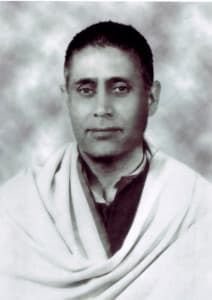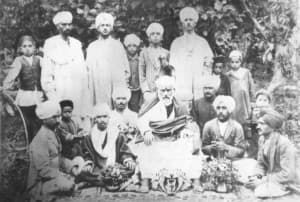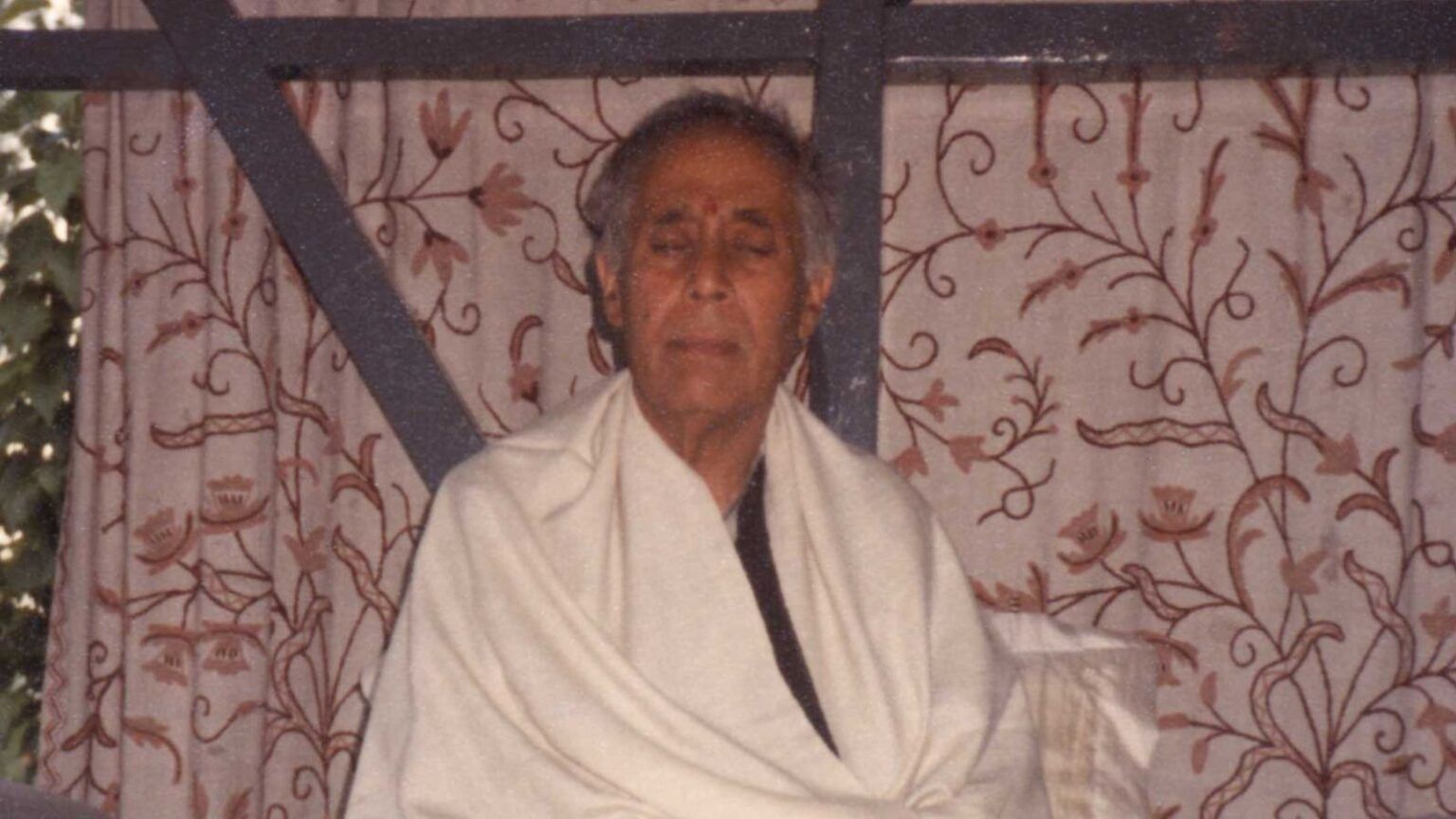Swami Lakshmanjoo

A brief history of the life of Swami Lakshmanjoo
Swami Lakshmanjoo was born on the 9th of May, 1907, in Srinagar, Kashmir, India. As a child he showed clear signs of spirituality, and from the age of three would become easily absorbed in his own inner nature. Too young to find the appropriate yogic expression, the young child described this state as “badhi bhod” which in Kashmiri means “greater than the greatest.”
The young boy approached his spiritual practice with burning zeal and had his first glimpse of God Consciousness at the age of nineteen. After that glimps of the Divine he took a vow of lifelong celibacy and dedication to the realization of the highest state of God Consciousness.
During the next three decades Swami Lakshmanjoo soaked himself in the oceanic depths of Kashmir Shaiva philosophy, at every step verifying his intellectual understanding with his own personal experience.
By 1965
By 1965, news had quietly spread that the oral tradition of Kashmir Shaivism was alive and well, fully embodied in the person of Swami Lakshmanjoo. For the next thirty years a regular stream of visitors from India and abroad sought his audience. To all sincere seekers Swamiji freely distributed the treasure of his wisdom.
As the last in an unbroken chain of Masters of this unique ‘oral tradition’ Swami Lakshmanjoo dedicated his life to the sacred teachings of Kashmir Shaivism. In 1991 he left this mortal world but not before giving clear guidelines for the future.

In India
In India, he established the Ishwara Ashram Trust to carry out activities in a manner which would uphold the truths he himself had lived for. In the United States, for the purpose of carrying his message to all who had a spiritual thirst and longed to know the ultimate truth of life, Swamiji laid the foundation for the establishment of the Universal Shaiva Fellowship, which later was re-established with a focus on education as the Lakshmanjoo Academy.
Line of Masters
Lord Shiva is infinite and eternal. He is beyond limitation and yet by his independent free will (svatantrya) he has the power to appear limited. He creates the universe for his own play, without beginning or end.
In the sixth chapter of his Tantraloka, Abhinavagupta explains in great detail, how in his own body, Lord Shiva creates different concepts of time, to cater to the infinite variety of beings who inhabit the one hundred and eighteen worlds or universes.
At the lower cycle of creation, there are sixteen worlds or Bhuvana’s, one of which is our own universe which contains the earth and solar system. Here, the full scale of human life is said to be one hundred years.
But the life of our earth and these other sixteen worlds runs into millions and millions of years, which are divided into smaller cycles of time called yugas.
The four yugas, known as satya, treta, dvapara and kali, together total 12,000 divine years, or 4,320,000 human years. These yugas are respectively more and more gross, similar to the golden, silver, bronze and iron ages of Greek Mythology.
In his translation of the 13th chapter of Tantraloka, Swami Lakshmanjoo tells us that, “in order to create this universe, Lord Shiva conceals his nature by manifesting himself in an infinite variety of beings. On the stage of this universe, he loses himself in the drama of life. Then, by his own sweet will, he reveals his true nature and elevates himself again to the state of Shiva.”
This is his play, and the sweetest part of this play is that Lord Shiva always appears at various times, and in various ways, for the upliftment of sincere seekers.
At the beginning of the present cycle of sat-yuga Lord Shiva appeared in the form of Svacchandanatha with five heads and his wonderful eighteen arms. In this form, he narrated the various scriptures (tantras) of our Shaivism.
In sat-yuga, treta-yuga, and dvapara-yuga, Masters and disciples were so great that they remembered everything instantaneously. There was no need to write anything down or refer to books, hence in those ages, they were initiated verbally.
When Kali-yuga occurred, these Masters and disciples became disappointed, they hid themselves in unknown places in order to avoid the touch of worldly people. Because of this, the theory of the Bhairava Tantras and Kashmir Shaivism was lost. Lord Shiva, however, always wishes to illuminate the universe, and so He reappeared in this world on Mount Kailash in the form of Shrikanthanatha. In this form He again taught the theory of the Bhairava Tantras to Durvasa Rishi. After telling Durvasa Rishi to expand the thought of Bhairava Tantras in all the universe without restriction of caste, creed, color, or gender, Shrikanthanath disappeared into the ether.
After meditating completely to acquire a real and fit disciple Durvasa Rishi became disappointed. He could not find anyone in this world fit to be initiated, so out of his mental power he created one mind-born son whom he called Tryambakanatha. Durvasa initiated him completely in the way of monistic Bhairava Tantras. Afterward, he created two more mind-born sons, Amardakanatha and Shrinatha whom he initiated into the dualistic Shiva Tantras and the mono-dualistic Rudra Tantras respectively. All of this was done by Durvasa Rishi for the upliftment of humankind.
Tryambakanatha created one mind-born daughter, whom he initiated completely in the monistic way. Known as the Ardhatryambaka school of the Bhairava Tantras, this teaching manifests itself secretly from one woman to another. Kashmir Shaivism does not recognize women as inferior. In fact, Swami Lakshmanjoo tells us, “If a woman remains one-pointed in her spiritual practice, she can achieve in twelve days what would normally take one year”. There is no history of this school in kali-yuga.
Durvasa Rishi’s mind-born son Tryambakanatha, also created his own mind-born son and named him Tryambakaditya, which means “the expansion of Tryambakanatha”. Tryambakaditya created his own mind-born son, and after initiating him he disappeared into the ether.
In this manner, fifteen generations of Siddha were created by mind. When, however, the fifteenth Siddha attempted to create a mind-born son, he was not successful. It is said he was not fully introverted, as he was also given to worldly pleasures. However, after sitting in long meditation, he found in this world a girl with good qualities and went to her father and made arrangements to marry.
They had one son named Sangamaditya who came to the valley of Kashmir. Like his father, Sangamaditya married and produced a son named Varshaditya, whom he initiated completely in the thought of the monistic Bhairava Tantras. Varshaditya married and produced a son named Arunaditya, whom he initiated fully. Arunaditya also married and created a son named Ananda, whom he initiated and who was also completely informed in all practical aspects of Shaivism. This sage Ananda was the father of Somananda, the originator of the Pratyabhijna School of Shaivism, and the author of the ‘Shiva Dristi’.
Up to this time (800 C.E.), initiation into the monistic thought of the Bhairava Tantras took place from father to son only. After Somananda this initiation took place from Master to disciple. Somananda was the master of Utpaladeva. Utpaladeva was the master of Lakshmanagupta. And Lakshmanagupta was the master of the great Abhinavagupta, (924-1020 CE).
Abhinavagupta had many masters of whom he considered Shambunatha, his master in the Kula System, to be the most illustrious.
Abhinavagupta was a complete authority on Kashmir Shaivism and although he had many disciples, both men and women, his chief disciple was Kshemaraja and the chief disciple of Kshemaraja was Yogaraja.
Since its beginning, the sacred lineage of Kashmir Shaiva Masters has remained unbroken, yet due to the rise and fall of Kashmir over the past 700 years, it has been practically hidden from view.
Mogul rule in Kashmir began in 1300 and ended in early 1800.
During that time many of the elevated masters went underground, and there are some indications of who they were, but not a lot of written information.
In 1860, Swami Manakak (also known as Swami Manas Ram Mongra) was recognized as a great Master of Kashmir Shaivism. He initiated Swami Ram (1852-1914), who became well-versed in the secrets of Trika Shaivism. Swami Ram’s chief disciple was Swami Mahatabakak and his disciple was Swami Lakshmanjoo (1907-1991).
Before Swami Mana Kak there was Gopal Razdan and Swami Lassa Kak, who were known as masters of the tradition, but due to the tyranny of the Patans (1700), their teachings were very subdued. It was Swami Ram who was instrumental in reviving the Shaiva texts, which were mostly handwritten manuscripts in Shraddha script. Through the Research Department, the Kashmir Series of Text and Studies (KSTS) transcribed all the major Shaiva texts into Devanagri, making it easier for Swami Lakshmanjoo to study those texts early in his life.
Swami Lakshmanjoo was the last in this unbroken chain of Kashmir Shaiva Masters.
Get to know Kashmir Shaivism
Learn MoreA Gift for You
We want to thank you for visiting with a gift that was given to us by Swamiji, as a reminder of how we should start our day. Please download, print out and share with others.
Sincerely,
John Hughes

Transcript: "Early in the mornings for all of you"
Sit motionless. Do not grumble of bad environments. Create your own mental world and environments. Build up your character properly. Establish virtuous healthy habits. Understand the glory, splendor & Power of God, who is at the back of your mind, thoughts, will and memory. Keep your body strong and healthy through regular exercise. Become a spiritual hero. Shut out the doors of the senses. Still the thoughts, emotions and feelings. Sit motionless and calm in the early morning hours. Have a receptive attitude. Go along with God. Enjoy peace in the silence. How I like these golden rules which have come out from some Divine lips.









